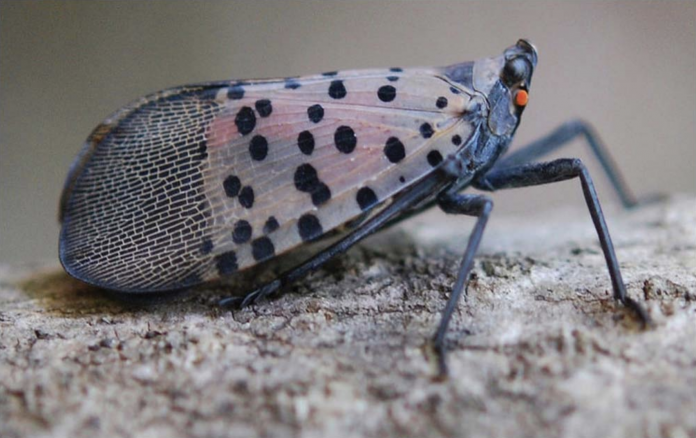
On a recent trip to visit a friend in western Pennsylvania, I experienced something that I have only heard and read about.
After lunch, we decided to walk around the property, and that is when I “spotted” them. The maple trees and invasive tree of heaven were covered in them and the outside of the house.
If you haven’t guessed what I am talking about yet, I am talking about a well-established spotted lanternfly infestation.
According to the Ohio Department of Agriculture, the spotted lanternfly is native to China, India and Vietnam and was first detected in eastern Pennsylvania in September 2014. They feed on more than 100 plant species such as fruit plants, ornamentals and woody trees, which could lead to decreases in production or death of these species. This could have disastrous results for our viticulture, tree fruit, nursery, and timber industries here in Ohio.
According to Pennsylvania Department of Agriculture’s website, a 2019 economic impact study estimates that this insect could cost Pennsylvania $324 million annually and more than 2,800 jobs, if left uncontrolled.
One of the tell-tale signs that spotted lanternfly may be present is the presence of black sooty mold at the base of plants or oozing sap, caused by the feeding of these insects.
This black sooty mold at the base of the maple trees was one of the first things I noticed during my visit. This led me to take a closer look, which is when I discovered the tree was covered in adult spotted lanternflies.
Upon further investigation, I also noticed the tree was oozing sap and covered in old egg masses. The spotted lanternfly life cycle starts with the egg masses, which are laid beginning in October through the start of winter. These egg masses are gray in color and protected by a waxy covering.
Then, after hatching in late spring, the insects will go through four nymph stages. In the first three stages, they are black with white spots and the last stage they are red with white spots and black stripes.
In late summer going into autumn, they are in the adult moth stage, which is what I observed during my visit. The adults are about 1 inch long and have a black body with brightly colored wings.
Even though the adults have wings, they can only fly short distances or move by walking or jumping. The long-distance spread of this insect is often the result of humans moving infested materials, such as firewood, nursery stock, rocks or outdoor furniture.
Talking with my friend and her family, they said they are really cautious when driving somewhere, being sure to remove any spotted lanternflies off their vehicles.
During my visit, I could not figure out why the outdoor table and chairs were in the middle of the sunny yard on a hot day and not under the nice shade trees. The family said they don’t like sitting under the trees because the spotted lanternflies would constantly jump or fly onto them, which I experienced first-hand in the short amount of time being there. Even walking back inside the house, you had to be quick or the insects would come inside as well.
I asked the family if they noticed any trees or shrubs dying, or if their garden was affected. They noticed that some of their trees, especially the maples, didn’t look as healthy, and all of their grape vines were dying. They said the numbers this year were much higher than last year and its always worse late summer going into fall.
Talking with the family and other people that work in Pittsburgh, I learned that they are just as bad downtown as they are in rural areas. In the downtown areas, they cover the sides of buildings, sidewalks and streetlamps and are constantly landing on people and cars, further helping them spread.
Some of you may be asking, what does this have to do with me here in Ohio, we don’t have spotted lanternfly in my county. Maybe you know or don’t know, but according to ODA’s website, quarantined counties in Ohio include Cuyahoga, Franklin, Hamilton, Jefferson, Lorain, Lucas, Mahoning and Muskingum.
These insects more than likely made their way to these counties by humans unknowingly moving infested materials. If we are observant and know what to look for, we can help stop or at least slow down the spread of these invasive insects. This will help protect our viticulture, tree fruit, nursery and timber industries here in Ohio for future generations to come.
Reading about spotted lanternfly is one thing, but experiencing it firsthand gives you a better understanding of the damage this invasive insect can do.
More information can be found on ODA’s website agri.ohio.gov/divisions/plant-health/invasive-pests/invasive-insects/slf or Pennsylvania Department of Agriculture website www.agriculture.pa.gov/Plants_Land_Water/PlantIndustry/Entomology/spotted_lanternfly/Pages/default.aspx.












